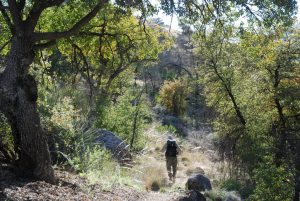Location
- Gordon Hirabayashi Campground to Marshall Gulch Trailhead
Length
- 19.0 miles
Resources
- MAP
- PROFILE
- TRACK
- Waypoints: GPS | MP
- Arizona Euro-American History
- USGS Topographic Maps: Agua Caliente Hill, Sabino Canyon and Mount Lemmon.
- Coronado National Forest map.
- BLM Information Center maps.
Southern Access Point: Gordon Hirabayashi Campground
- GPS Coordinates: 32.33581° N, 110.71972° W
Access
Follow Tanque Verde Road east from Tucson and turn left (north) on the Catalina Highway. Drive about 9 miles and pass Molino Basin Campground. Continue 1.7 miles beyond the campground and take the left (west) turn to Gordon Hirabayashi Campground. Drive 0.3 miles to a parking area. Follow a trail out of the south end of the parking lot for 40 yards to reach a “T” intersection with the AZT.
Northern Trailhead: Marshall Gulch Trailhead
- GPS Coordinates:32.42834° N, 110.75569° W
Access
Take Catalina Highway into the Santa Catalina Mountains. Near the top of the mountain range, bear left to the community of Summerhaven. Continue 1.5 miles south to the end of the road at the Marshall Gulch Trailhead. The trailhead is on the west side of the parking area.
Trail Route Description
Passage 11 traverses the Santa Catalina Mountains, including Sabino Canyon and the Pusch Ridge Wilderness. This section features extreme changes in elevation and climate, along with unique biodiversity and refreshing swimming pools – a rare treat along the AZT!
The trail rises and falls through dry grasslands, deep canyons, and dense forests. It features spectacular swimming holes, sentinel saguaros, and steep, strenuous miles.
This section begins with a descent towars Sabino Canyon, a spectacular desert oasis with lush valleys and rich riparian corridors tucked between rocky canyon cliffs. The trail winds along the West Fork of Sabino Canyon and passes by Hutch’s Pool, a spectacular swimming hole, and fantastic camping spot tucked away in the mountains. These unique desert watering holes are popular amongst the Tucson locals and can get crowded on the weekends.
After leaving Hutch’s Pool, the trail climbs steeply through dense forests and granite boulders, including a vertical mile to reach Romero Pass.
The trail continues to climb northeast towards Mount Lemmon, the highest point in the Santa Catalinas, where temperatures can be up to 20 degrees cooler than in the valley (a side trip to the highpoint of this range would add 6.8 miles to the total length of this passage).
Within the Wilderness of Rock, the trail continues to rise and fall through a dense forest of pine trees and oaks. It passes through granite outcrops with unique rock formations, crosses Lemmon Creek, and then makes a final, short descent to Marshall Gulch and the end of this passage.
Difficulty
- Moderate to Difficult
Season(s)
All year. Snow can be present at higher elevations after winter storms and lower elevations can be quite warm in summer
Water
Water can sometimes be found at Sycamore Canyon usually at Hutch’s Pool, and seasonal water at Lemmon Creek. Check the online Arizona Trail Water Report for current information at https://aztrail.org/explore/water-sources/.
Notes/Warnings
- All water along this passage should be purified prior to use.
- There is a large, deep swimming hole on this passage at Hutch’s Pool.
For more information
- The Passage Steward
- Coronado National Forest, Santa Catalina Ranger District, 5700 N. Sabino Canyon Rd., Tucson, AZ 85715 (520) 749-8700.
- BLM Information Center (602) 417-9300.















